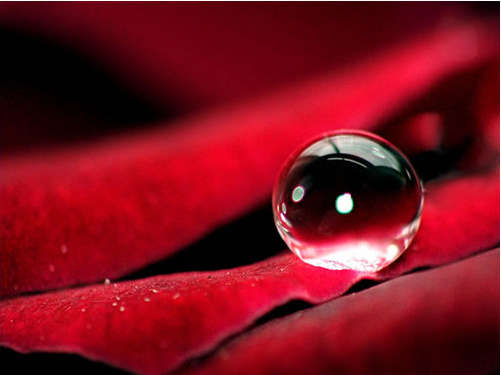FWP:
SETS == A,B; GENERATORS
This verse has always nagged at my mind, because it's such a classic, unresolvable case of enigmatic 'A,B' structure. The two lines are grammatically and semantically quite independent. So how are we to decide on the connection between them? Do both lines basically describe the same situation? Is one to be considered a cause, and one a reaction or result-- and if so, which way around? Or are the situations in the two lines meant to be contrasted?
One reason that these relationships are hard to resolve is the complexity and abstractness of the information we're given. Even in the first line, adaa can be either a passive, even involuntary quality ('grace, beauty, elegance') or a very active one ('blandishment, amorous signs and gestures, coquetry'). So we don't know whether the dewdrops are flaunting their beauty and preening themselves flirtatiously, or are merely innocent bystanders who have no idea of their own attractions. This dual possibility means we're hopelessly unable to pin down the further multivalences in the second line.
For in the second line, the ambiguities are piled on top of each other. A daa;G is either a 'wound' or a 'scar', so it might be either something recent or something experienced long ago. In any case, it's clearly established in the ghazal world that the tulip has exactly such a daa;G ; on this, see {33,1}.
A heart that is be-dard is without 'pain, ache'-- or else without 'pity, compassion'-- or even without 'affection' (see the definition above). And the somewhat elusive ;hayaa might refer to the kind of 'shame' that is a sign of innocence and virtue ('modesty, shyness'); or else to the kind of embarrassment or sense of shame that results from an awareness of improper behavior.
There's also the enjoyably paradoxical na:zar-gaah-e ;hayaa , a 'viewing-place' or 'theater' of the very quality that would make one unwilling to be publically viewed.
In short, the dewy tulip might be full of innocent loveliness,
or else shameless flirtation. And the wound or scar in a heart that is without
pain, or else without pity or sympathy, may be that of the tulip, or that
of a lover, or just a general abstraction; and its moral status may be as
a display or theatrical spectacle either of becoming and suitable modesty, or else of embarrassment
and real shame (at wrongdoing or impropriety?). We can mix them and match them as we like, and take our pick.

Nazm:
On the tulip-flower the dewdrops are fulfilling a purpose. It is this: in the heart in which there would be no pain, and there would come to be a wound/scar, it is an occasion for shame. That is, the tulip has a wound, but is devoid of the pain of passion, and this fact is for it a cause of shame. And out of embarrasment, it reveals the 'sweat of shame' [((araq-e sharm]. In the first line, for nah to be with hai is contrary to the idiom. Instead of nah hai one ought to say nahii;N . (259)
== Nazm page 259